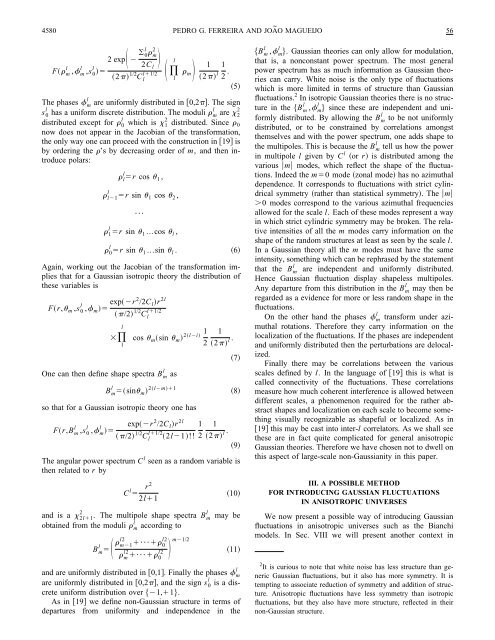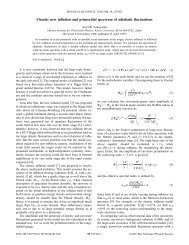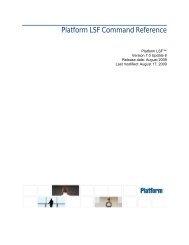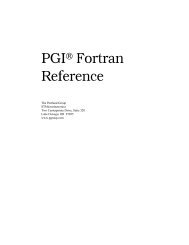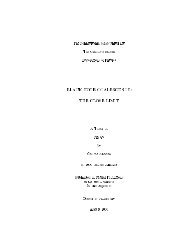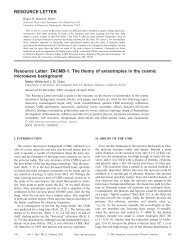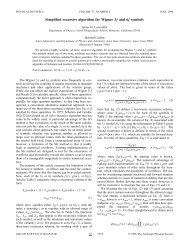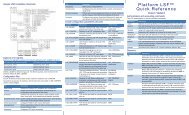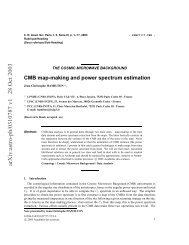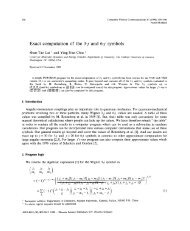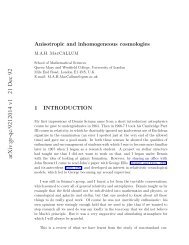56 CLOSET NON-GAUSSIANITY OF ANISOTROPIC ...4579turns out, however, that these large-angle <strong>non</strong>-<strong>Gaussian</strong> effectsare largely due to the last texture as in the textureclosest to us, or the texture at lower redshift. The culpritidentified, one then notices that conditionalizing the theory tothe last texture redshift z 1 reveals a <strong>Gaussian</strong> ensemble, thatis, the probability distribution P(a m l z 1 ) is <strong>Gaussian</strong>. Marginalizingwith respect to z 1 , however, produces a <strong>non</strong>-<strong>Gaussian</strong> ensemble, that is the probabilityPa ml dz 1 Pz 1 Pa m l z 1 is <strong>non</strong>-<strong>Gaussian</strong>.The picture is then clear 17. We come up with a constructionwhere the full ensemble is made up <strong>of</strong> subensembleswhich are <strong>Gaussian</strong>. Each subensemble is howeverlabeled by an index which from the point <strong>of</strong> view <strong>of</strong> the fullensemble is a random variable. Marginalizing with respect tothis variable reveals a <strong>non</strong>-<strong>Gaussian</strong> ensemble. Conditionalizingwith respect to this index renders the theory <strong>Gaussian</strong>.Such an index was called in 12 the random index, and itwas conjectured 1 in that paper that <strong>non</strong>-<strong><strong>Gaussian</strong>ity</strong> could<strong>of</strong>ten be characterized by a set <strong>of</strong> such indices labeling<strong>Gaussian</strong> ensembles. Within such a construction the strategyfor predicting experiment must be modified. One should nownot provide a direct statistical description <strong>of</strong> the full ensemblethat is, marginal distributions, which would beplagued by all sorts <strong>of</strong> <strong>non</strong>-<strong>Gaussian</strong> effects. Rather it makesmore sense to supply information on all the <strong>Gaussian</strong> subensembles,plus the distribution function <strong>of</strong> their random indices.Hence we may use a subclass <strong>of</strong> the comprehensive formalismfor encoding large-angle <strong>non</strong>-<strong><strong>Gaussian</strong>ity</strong> outlined in10 to describe <strong>anisotropic</strong> <strong>Gaussian</strong> <strong>fluctuations</strong>. This isessentially a large-angle generalization <strong>of</strong> 19 and is describedin Sec. II. The idea is to complement the angularpower spectrum C l with a set <strong>of</strong> multipole shape spectra B mdescribing how the power is distributed among the m’s for agiven scale l. The B m encode information on the shape <strong>of</strong>large angle structures. They are uniformly distributed in a<strong>Gaussian</strong> isotropic theory, meaning its <strong>fluctuations</strong> areshapeless. However, as we shall see in Sec. V, preferredshapes emerge in <strong>non</strong>-<strong>Gaussian</strong> isotropic theories, as well asin <strong>Gaussian</strong> <strong>anisotropic</strong> theories, where the B m are not uniformlydistributed. Non-<strong>Gaussian</strong> spectra then appear as anatural predictive tool for these theories.In this paper we study the disguised <strong>non</strong>-<strong><strong>Gaussian</strong>ity</strong> <strong>of</strong><strong>anisotropic</strong> <strong>Gaussian</strong> <strong>fluctuations</strong> along two lines. Firstly, inSec. III, we propose a simple method for defining <strong>anisotropic</strong><strong>Gaussian</strong> <strong>fluctuations</strong>. Breaking isotropy essentially amountsto choosing an alternative symmetry group under which thecovariance matrix should be invariant, and which picks afavored direction in the sky. We can then write down themost general form for the covariance matrix <strong>of</strong> the theorysimply by studying the representation theory <strong>of</strong> the symmetrygroup. We argue that the accidental symmetry allowing<strong>anisotropic</strong> <strong>fluctuations</strong> to be isotropic is a model dependent1 This conjecture can in fact be promoted to a mathematical theorem;see 18.3and unnatural assumption. Hence <strong>Gaussian</strong> <strong>fluctuations</strong> in<strong>anisotropic</strong> universes should be <strong>anisotropic</strong> too. Although weconcentrate on <strong>anisotropic</strong> <strong>fluctuations</strong> with an SO2 symmetry,the definition and considerations given in Sec. II arequite general, as explained in more detail in Appendix A.We then show how <strong>anisotropic</strong> <strong>Gaussian</strong> theories inducewell known <strong>non</strong>-<strong>Gaussian</strong> effects in the relation between theobserved and the predicted angular power spectrum C l .These effects include larger cosmic variance error bars, andalso the phenome<strong>non</strong> <strong>of</strong> cosmic covariance, that is correlationsbetween the observed C l . Cosmic covariance allowsfor more structure to exist in each realization than in thepredicted average power spectrum and complicates comparisonbetween theory and experiment. These effects are shownto be present for <strong>anisotropic</strong> <strong>Gaussian</strong> theories in Sec. IV.Then, in Sec. V, we show how <strong>anisotropic</strong> <strong>Gaussian</strong> <strong>fluctuations</strong>render <strong>non</strong>-<strong>Gaussian</strong> spectra <strong>non</strong>uniformly distributed,as announced above. We also find the most generalclass <strong>of</strong> isotropic <strong>non</strong>-<strong>Gaussian</strong> theories into which <strong>anisotropic</strong><strong>Gaussian</strong> <strong>fluctuations</strong> may be mapped. As a concreteexample in Sec. VI we proceed to characterize the <strong>non</strong>-<strong>Gaussian</strong> spectra for the relevant, globally <strong>anisotropic</strong> spacetimes.Along a totally different line in Sec. VIII we construct asimple example <strong>of</strong> a topologically <strong>non</strong>trivial space time andshow how the <strong>non</strong>-<strong>Gaussian</strong> spectra will indicate <strong>anisotropic</strong>topological identifications. We propose this as an <strong>anisotropic</strong>Grischuk-Zel’Dovich effect: from subhorizon, large angleobservables we can characterize super-horizon anisotropies.In Sec. IX we discuss the implications <strong>of</strong> our results andtheir practical implementation.II. LARGE-ANGLE NON-GAUSSIANITYWe now set up a formalism for describing large-anglel<strong>non</strong>-<strong><strong>Gaussian</strong>ity</strong> which is based on 19, but makes use <strong>of</strong> a mcoefficients rather than Fourier components, and so is suitablefor mapping large-angle <strong>non</strong>-<strong><strong>Gaussian</strong>ity</strong>. Again theidea is to map the a l m into a set <strong>of</strong> spectra which for a<strong>Gaussian</strong> isotropic theory are independent random variables.One <strong>of</strong> these spectra is the angular power spectrum C l , and2should be a 2l1 for a <strong>Gaussian</strong> isotropic theory. The othervariables make up <strong>non</strong>-<strong>Gaussian</strong> spectra which should beuniformly distributed for a <strong>Gaussian</strong> isotropic theory.The transformation proposed is defined as follows. Firstwe split the complex modes into moduli and phasesa 0 l s 0 l 0 l ,a l m lm l& ei m ,where s l 0 1 is simply the sign <strong>of</strong> a l 0 . The fact that them0 mode is real introduces a slight modification to theconstruction in 19. There are now l1 moduli, but thereare only l phases the index m starts at 1 for the phases.Working out the Jacobian <strong>of</strong> the transformation shows thatl lfor a <strong>Gaussian</strong> theory the distribution <strong>of</strong> the m , m ,s l 0 is4
4580 PEDRO G. FERREIRA AND JOÃO MAGUEIJO56F ml, ml,s 0 l 2 exp 0l 2 m2C l2 1/2 C ll1/2 1l m12 l 12 . 5lThe phases m are uniformly distributed in 0,2. The signll 2s 0 has a uniform discrete distribution. The moduli m are 2ldistributed except for 0 which is 2 1 distributed. Since 0now does not appear in the Jacobian <strong>of</strong> the transformation,the only way one can proceed with the construction in 19 isby ordering the ’s by decreasing order <strong>of</strong> m, and then introducepolars: l l r cos 1 ,l l1 r sin 1 cos 2 ,••• 1 l r sin 1 ...cos l , 0 l r sin 1 ...sin l .Again, working out the Jacobian <strong>of</strong> the transformation impliesthat for a <strong>Gaussian</strong> isotropic theory the distribution <strong>of</strong>these variables isFr, m ,s l 0 , m expr2 /2C l r 2l/2 1/2 l1/2C l1lOne can then define shape spectra B mlcos m sin m 2li 1 2asB m l sin m 2lm1so that for a <strong>Gaussian</strong> isotropic theory one has12 l .lFr,B m ,s l expr 2 /2Cll r 2l 1 10 , m /2 1/2 C l1/2 l 2l1!! 2 2 l .9The angular power spectrum C l seen as a random variable isthen related to r by2and is a 2l1lobtained from the moduli mr2C l 2l1. The multipole shape spectra B mlB m l according to l2l2m1••• 0 l2 l2m ••• 0m1/267810may be11land are uniformly distributed in 0,1. Finally the phases mlare uniformly distributed in 0,2, and the sign s 0 is a discreteuniform distribution over 1,1.As in 19 we define <strong>non</strong>-<strong>Gaussian</strong> structure in terms <strong>of</strong>departures from uniformity and independence in the, l m . <strong>Gaussian</strong> theories can only allow for modulation,that is, a <strong>non</strong>constant power spectrum. The most generalpower spectrum has as much information as <strong>Gaussian</strong> theoriescan carry. White noise is the only type <strong>of</strong> <strong>fluctuations</strong>which is more limited in terms <strong>of</strong> structure than <strong>Gaussian</strong><strong>fluctuations</strong>. 2 In isotropic <strong>Gaussian</strong> theories there is no structurein the B m , l m since these are independent and uni-llformly distributed. By allowing the B m to be not uniformlydistributed, or to be constrained by correlations amongstthemselves and with the power spectrum, one adds shape tolthe multipoles. This is because the B m tell us how the powerin multipole l given by C l or r is distributed among thevarious m modes, which reflect the shape <strong>of</strong> the <strong>fluctuations</strong>.Indeed the m0 mode zonal mode has no azimuthaldependence. It corresponds to <strong>fluctuations</strong> with strict cylindricalsymmetry rather than statistical symmetry. The m0 modes correspond to the various azimuthal frequenciesallowed for the scale l. Each <strong>of</strong> these modes represent a wayin which strict cylindric symmetry may be broken. The relativeintensities <strong>of</strong> all the m modes carry information on theshape <strong>of</strong> the random structures at least as seen by the scale l.In a <strong>Gaussian</strong> theory all the m modes must have the sameintensity, something which can be rephrased by the statementlthat the B m are independent and uniformly distributed.Hence <strong>Gaussian</strong> fluctuation display shapeless multipoles.lAny departure from this distribution in the B m may then beregarded as a evidence for more or less random shape in the<strong>fluctuations</strong>.lOn the other hand the phases m transform under azimuthalrotations. Therefore they carry information on thelocalization <strong>of</strong> the <strong>fluctuations</strong>. If the phases are independentand uniformly distributed then the perturbations are delocalized.Finally there may be correlations between the variousscales defined by l. In the language <strong>of</strong> 19 this is what iscalled connectivity <strong>of</strong> the <strong>fluctuations</strong>. These correlationsmeasure how much coherent interference is allowed betweendifferent scales, a phenome<strong>non</strong> required for the rather abstractshapes and localization on each scale to become somethingvisually recognizable as shapeful or localized. As in19 this may be cast into inter-l correlators. As we shall seethese are in fact quite complicated for general <strong>anisotropic</strong><strong>Gaussian</strong> theories. Therefore we have chosen not to dwell onthis aspect <strong>of</strong> large-scale <strong>non</strong>-<strong><strong>Gaussian</strong>ity</strong> in this paper.B mlIII. A POSSIBLE METHODFOR INTRODUCING GAUSSIAN FLUCTUATIONSIN ANISOTROPIC UNIVERSESWe now present a possible way <strong>of</strong> introducing <strong>Gaussian</strong><strong>fluctuations</strong> in <strong>anisotropic</strong> universes such as the Bianchimodels. In Sec. VIII we will present another context in2 It is curious to note that white noise has less structure than generic<strong>Gaussian</strong> <strong>fluctuations</strong>, but it also has more symmetry. It istempting to associate reduction <strong>of</strong> symmetry and addition <strong>of</strong> structure.Anisotropic <strong>fluctuations</strong> have less symmetry than isotropic<strong>fluctuations</strong>, but they also have more structure, reflected in their<strong>non</strong>-<strong>Gaussian</strong> structure.


